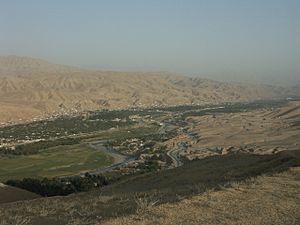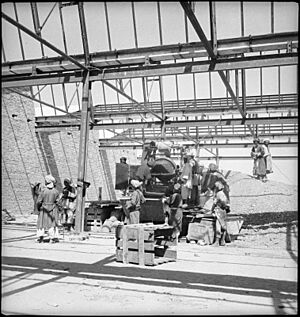Puli Khumri facts for kids
Quick facts for kids
Puli Khumri
پل خمری
|
|
|---|---|

View of the city
|
|
| Country | |
| Province | Baghlan Province |
| District | Puli Khumri District |
| Area | |
| • Total | 3,752 ha (9,271 acre) |
| Elevation | 920 m (3,020 ft) |
| Population
(2014-2015)
|
|
| • Total | 221,274 |
| Population Total is Estimated | |
| Time zone | UTC+4:30 (Afghanistan Time) |
Puli Khumri (Persian: پل خمری), also spelled Pul-i-Khumri or Pol-e Khomri, is a big city in northern Afghanistan. It is the capital and largest city of Baghlan Province. The city had about 221,274 people living there in 2015. This makes it one of Afghanistan's largest cities. Puli Khumri is also an important city for factories and businesses.
Contents
History of Puli Khumri
The capital of Baghlan Province was moved to Puli Khumri from the city of Baghlan in the 1980s. This change happened because Puli Khumri is in a better location. It is on the main highway that connects Kabul and Mazar-i-Sharif. This made it easier for people to reach government offices.
In August 2021, Puli Khumri became one of the first provincial capitals to be taken over by the Taliban during their nationwide military actions.
Geography of Puli Khumri
Puli Khumri is located about 100 kilometers (60 miles) south of Kunduz. It is also about 200 kilometers (120 miles) southeast of Mazar-i-Sharif. The city is about 230 kilometers (140 miles) north of Kabul. Its location makes it an important center for trade and travel in the region.
How Land is Used
In 2015, Puli Khumri had six main areas called districts. The total land area of the city was about 3,752 hectares. A hectare is a unit of area, like a very large field. There were 24,586 homes in the city.
Most of the land in Puli Khumri (65%) is used for farming. This is especially true in Districts 3, 5, and 6. Districts 1 and 2 have the most homes packed together. However, District 5 has the highest number of homes overall. The city has many different types of houses, including regular houses, houses built in an unplanned way, and houses on hillsides. There are also apartment buildings.
Climate in Puli Khumri
Puli Khumri has a cold semi-arid climate. This means it is generally dry, but not a desert, and it can get quite cold. The average temperature in Puli Khumri is 15.9°C (60.6°F). The city gets about 282 millimeters (11 inches) of rain each year.
July is the warmest month, with an average temperature of 28.5°C (83.3°F). January is the coldest month, with an average temperature of 3.0°C (37.4°F).
| Climate data for Puli Khumri | |||||||||||||
|---|---|---|---|---|---|---|---|---|---|---|---|---|---|
| Month | Jan | Feb | Mar | Apr | May | Jun | Jul | Aug | Sep | Oct | Nov | Dec | Year |
| Mean daily maximum °C (°F) | 8.3 (46.9) |
10.9 (51.6) |
16.2 (61.2) |
21.8 (71.2) |
28.7 (83.7) |
35.3 (95.5) |
37.1 (98.8) |
35.9 (96.6) |
31.6 (88.9) |
24.8 (76.6) |
15.7 (60.3) |
9.6 (49.3) |
23.0 (73.4) |
| Daily mean °C (°F) | 3.0 (37.4) |
5.7 (42.3) |
10.7 (51.3) |
16.0 (60.8) |
21.3 (70.3) |
26.5 (79.7) |
28.5 (83.3) |
27.0 (80.6) |
22.5 (72.5) |
16.5 (61.7) |
9.1 (48.4) |
4.2 (39.6) |
15.9 (60.7) |
| Mean daily minimum °C (°F) | −2.2 (28.0) |
0.6 (33.1) |
5.3 (41.5) |
10.2 (50.4) |
14.0 (57.2) |
17.8 (64.0) |
19.9 (67.8) |
18.1 (64.6) |
13.4 (56.1) |
8.2 (46.8) |
2.5 (36.5) |
−1.1 (30.0) |
8.9 (48.0) |
| Average precipitation mm (inches) | 31 (1.2) |
43 (1.7) |
63 (2.5) |
65 (2.6) |
27 (1.1) |
0 (0) |
0 (0) |
0 (0) |
0 (0) |
8 (0.3) |
20 (0.8) |
25 (1.0) |
282 (11.2) |
Population of Puli Khumri
| Population census | ||
|---|---|---|
| Year | Pop. | ±% p.a. |
| 2002 (est.) | 60,000 | — |
| 2006 (est.) | 180,800 | +31.75% |
| 2007 (est.) | 58,300 | −67.75% |
Economy and Industry
Puli Khumri has two dams that help provide electricity to the city.
Afghanistan's first cement factory, called Ghori I Cement Factory, was built in Puli Khumri in 1954. It was built with help from Czechoslovakia. This factory still operates today. It gets its main material, limestone, from a hill right behind the factory.
There is also a coal mine near the city in a village called Kar-kar.
Farming is very important in Puli Khumri because of the rain and good temperatures. The main crops grown here are wheat, different spices, and rice.
Provincial Reconstruction Team
A Provincial Reconstruction Team (PRT) is a group of military and civilian experts from different countries. They work together to help rebuild and stabilize areas in conflict. From 2006 to 2013, Hungary led the PRT in Puli Khumri. Before that, the Netherlands was in charge.
Electricity lines built from Puli Khumri now provide a steady supply of power to Kabul, the capital city of Afghanistan.
See also
 In Spanish: Puli Khumri para niños
In Spanish: Puli Khumri para niños



